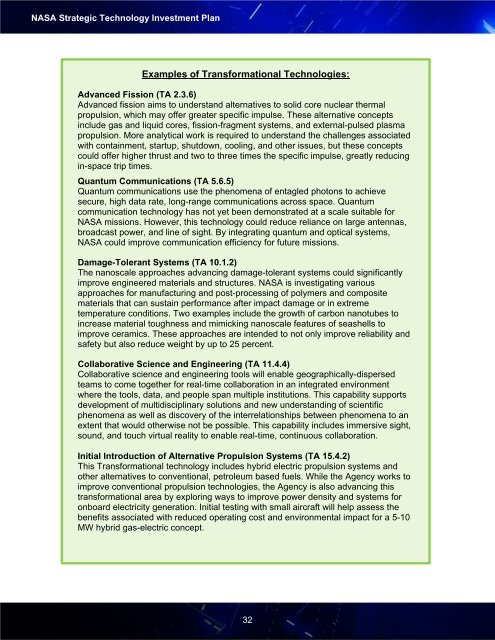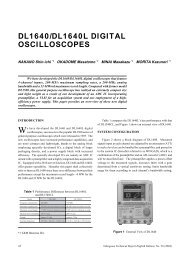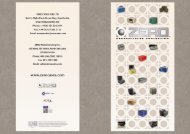2017-8-1_stip_final-508ed
Create successful ePaper yourself
Turn your PDF publications into a flip-book with our unique Google optimized e-Paper software.
NASA Strategic Technology Investment Plan<br />
Examples of Transformational Technologies:<br />
Advanced Fission (TA 2.3.6)<br />
Advanced fission aims to understand alternatives to solid core nuclear thermal<br />
propulsion, which may offer greater specific impulse. These alternative concepts<br />
include gas and liquid cores, fission-fragment systems, and external-pulsed plasma<br />
propulsion. More analytical work is required to understand the challenges associated<br />
with containment, startup, shutdown, cooling, and other issues, but these concepts<br />
could offer higher thrust and two to three times the specific impulse, greatly reducing<br />
in-space trip times.<br />
Quantum Communications (TA 5.6.5)<br />
Quantum communications use the phenomena of entagled photons to achieve<br />
secure, high data rate, long-range communications across space. Quantum<br />
communication technology has not yet been demonstrated at a scale suitable for<br />
NASA missions. However, this technology could reduce reliance on large antennas,<br />
broadcast power, and line of sight. By integrating quantum and optical systems,<br />
NASA could improve communication efficiency for future missions.<br />
Damage-Tolerant Systems (TA 10.1.2)<br />
The nanoscale approaches advancing damage-tolerant systems could significantly<br />
improve engineered materials and structures. NASA is investigating various<br />
approaches for manufacturing and post-processing of polymers and composite<br />
materials that can sustain performance after impact damage or in extreme<br />
temperature conditions. Two examples include the growth of carbon nanotubes to<br />
increase material toughness and mimicking nanoscale features of seashells to<br />
improve ceramics. These approaches are intended to not only improve reliability and<br />
safety but also reduce weight by up to 25 percent.<br />
Collaborative Science and Engineering (TA 11.4.4)<br />
Collaborative science and engineering tools will enable geographically-dispersed<br />
teams to come together for real-time collaboration in an integrated environment<br />
where the tools, data, and people span multiple institutions. This capability supports<br />
development of multidisciplinary solutions and new understanding of scientific<br />
phenomena as well as discovery of the interrelationships between phenomena to an<br />
extent that would otherwise not be possible. This capability includes immersive sight,<br />
sound, and touch virtual reality to enable real-time, continuous collaboration.<br />
Initial Introduction of Alternative Propulsion Systems (TA 15.4.2)<br />
This Transformational technology includes hybrid electric propulsion systems and<br />
other alternatives to conventional, petroleum based fuels. While the Agency works to<br />
improve conventional propulsion technologies, the Agency is also advancing this<br />
transformational area by exploring ways to improve power density and systems for<br />
onboard electricity generation. Initial testing with small aircraft will help assess the<br />
benefits associated with reduced operating cost and environmental impact for a 5-10<br />
MW hybrid gas-electric concept.<br />
32







